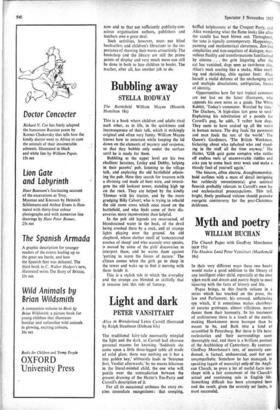Light and dark
PETER VANSITTART
Alice in Wonderland Lewis Carroll illustrated by Ralph Steadman (Dobson 63s) The traditional fairy-tale necessarily mingled the light and the dark, as Carroll had abstruse personal reasons for knowing. 'Suddenly she came upon a little three-legged table all made of solid glass; there was nothing on it but a tiny golden key,' ultimately leads to 'Sentence first, Verdict afterwards,' by no means hilarious to the literal-minded child, the one who will puzzle over the contradiction between the present drawing of the Hatter's Tea-Party and Carroll's description of it.
For all its occasional archness the story ex- cites immediate recognitions: that creeping,
baffled helplessness at the Croquet Party, ar.d Alice wondering what the flame looks like after the candle has been blown out. Throughout, the tone is signally contemporary. Happenings, punning and mathematical cleverness, Zen-like simplicities and non-sequiturs of dialogue, mar- vellous fluidity and transformations familiarised by cinema . . . the grin lingering after the cat has vanished, dogs seen as cart-horse size, Alice's neck soaring like a snake, Alice swell- ing and shrinking, chin against foot: Alice herself a stolid defence of the unchanging self and multiple dissolutions, ambiguities, freaks of identity.
Opportunities here for tart topical comment are not lost on the latest illustrator, who appends his own notes as a guide. The While Rabbit, `Today's commuter. Worried by time.' The Duchess, 'A high-class tart gone to seed.' Explaining his substitution of a poodle for Carroll's pug, he adds, 'I rather hate dogs. They seem to have soaked up,. all the worst in human nature. The dog fouls the pavement and man fouls the rest of the world.' The Queen's Gardeners, 'The British Workman, bickering about who splashed who and stand- ing in the stuff all the time anyway.' The Hatter, 'Glib quiz game compere who rattles off endless reels of unanswerable riddles and asks you to come back next week and make a bloody fool of yourself again.'
The bizarre, often electric, draughtsmanship, bold outlines with a mass of detail intriguing but ruthlessly unsentimental, give satirical flourish probably relevant to Carroll's own lay and ecclesiastical preoccupations. This tall, bright, finely produced volume should provoke energetic controversy for the post-Christmas doldrums.










































 Previous page
Previous page